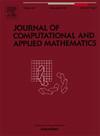考虑岩石可压缩性的多孔介质两相流热力学一致性模型的线性有效结构保持方法
IF 2.6
2区 数学
Q1 MATHEMATICS, APPLIED
Journal of Computational and Applied Mathematics
Pub Date : 2025-02-19
DOI:10.1016/j.cam.2025.116569
引用次数: 0
摘要
本文首先重新建立了具有岩石可压缩性的多孔介质中不可压缩和非混相两相流的热力学一致性模型,并基于稳定广义标量辅助变量(sGSAV)方法,在时间上采用新的松弛方法,在空间上采用逆风策略,构建了基于细胞中心有限差分(CCFD)方法的线性高效方案。所构建的格式是线性的,只需要求解一个泊松型方程,并且可以完全解耦求解每个时间步长的饱和度和压力。严格证明了所构造的方案在适当条件下是无条件能量稳定、各相和孔体积局部质量守恒和保界的。此外,我们还在原模型的基础上利用函数变换方法构造了一种新的无条件保界算法,以更好地反映全局压力的影响。最后,通过数值算例验证了所提方案的可靠性和有效性。本文章由计算机程序翻译,如有差异,请以英文原文为准。
The linear and efficient structure-preserving method for the thermodynamical consistent model of two-phase flow in porous media with rock compressibility
In this paper, we first reformulate the thermodynamically consistent model of incompressible and immiscible two-phase flow in porous media with rock compressibility and construct linear and efficient scheme based on the stabilized generalized scalar auxiliary variable (sGSAV) approach with the new relaxation in time and cell-centered finite difference (CCFD) method with upwind strategy in space. The constructed scheme is linear, only needs to solve one Poisson type equation and can be fully decoupled to solve the saturation and pressure at each time step. We rigorously prove that the constructed scheme is unconditionally energy stable, local mass conservative for each phase as well as pore volume, and bounds-preserving under appropriate conditions. In addition, we also construct a novel unconditionally bounds-preserving algorithm by using function transform approach based on the original model to better reflect the effect of global pressure. Finally, the reliability and efficiency of the proposed schemes can be verified through various numerical examples.
求助全文
通过发布文献求助,成功后即可免费获取论文全文。
去求助
来源期刊
CiteScore
5.40
自引率
4.20%
发文量
437
审稿时长
3.0 months
期刊介绍:
The Journal of Computational and Applied Mathematics publishes original papers of high scientific value in all areas of computational and applied mathematics. The main interest of the Journal is in papers that describe and analyze new computational techniques for solving scientific or engineering problems. Also the improved analysis, including the effectiveness and applicability, of existing methods and algorithms is of importance. The computational efficiency (e.g. the convergence, stability, accuracy, ...) should be proved and illustrated by nontrivial numerical examples. Papers describing only variants of existing methods, without adding significant new computational properties are not of interest.
The audience consists of: applied mathematicians, numerical analysts, computational scientists and engineers.

 求助内容:
求助内容: 应助结果提醒方式:
应助结果提醒方式:


